/Bridge-Stories-Articles_Issue1.asp
Issue 1 | June 2022
Welcome to Bridge Stories
Adrian Massey, Chief Executive
Curious: Truro artefacts amaze all !
By Amy, Blisland Primary School
This term, Blisland Primary Academy visited Truro Museum for learning experiences where they went back in time. Kenza Class had an amazing view of fossils, while Nessa Class (Key Stage 2) explored the Stone Age history and Egyptian life.
In these fascinating workshops, where the staff engaged the curiosity of all of the children, there was a chance to create a Stone Age master piece of a bowl or cup. A Year 6 pupil told us that; “It was a really good experience because we had the chance to study the other brown pottery bowls first and then afterwards we made our own and used our own creativity.”
After the Stone Age artistry was explored, Nessa Class shared what they had been learning in school with the staff. The staff, who were extremely impressed with their knowledge, then went on to explain many new facts to the children. Another Year 6 pupil commented that it had been good to learn ‘outside of the classroom too’ and said, “We saw many new artefacts and objects and we didn’t know what they were – the staff explained things to us really clearly and in a way that was interesting”.

Above: Nessa Class explore Stone Age Mastery
In the afternoon, the classes swapped and Nessa Class had the opportunity to explore the Egyptian ‘world’. The highlight was the chance to see a real, mummified ‘Mummy’ – covered in black tar. The children were amazed to discover that it was 2,500 years old and were shocked at how well it had been preserved. The Ancient Egyptians lived around the River Nile in Egypt up to about 6000 years ago. Museums know quite a lot about how they lived and died because of the objects and monuments they left behind, such as mummified cats, mummified crows, clothes and jewelry.
The Museum staff inspired the class with facts about the man; his name was Iset Tayef Nahkt and he had been a carpenter. This is known because the Egyptians wrote on his coffin with hieroglyphs.
Bridge Stories asked Mr Avery, the Headteacher, for his view on the trip and how it had shown that we are ‘curious’ in our learning (which is one of our values) and he said, “With a magnificent building filled with mysterious artefacts from pre-history to the modern day, the children instantly began to wonder, ask questions, search for answers: they were filled with curiosity and quickly made links to their history knowledge and learning. The children came away with more knowledge and understanding; and were even more curious to learn.”
Back
Responsible: Schools take action to save hedgehogs
By Emily, Blisland Primary School
On Thursday, 10th February, several groups of children from Bridge Schools were delighted to take part in a virtual tour of Prickles and Paws Hedgehog Sanctuary near Newquay.
The fortunate groups of schools were Pelynt Primary Academy, St Cleer Primary Academy and Blisland Primary Academy. Recently, these schools have been studying hedgehogs and learning about the reasons why these creatures are currently on the UK ‘Red List’ (endangered species). The children were keen to learn more about them and make sure their numbers do not fall any further. To attend this virtual trip, each child had to write a persuasive letter to their Headteacher, explaining how helpful it would be and how important it was to hear what the experts had to say.
The Education Officer, who was called Emma, showed the children around the sanctuary, showing off their prickly friends; the hedgehogs certainly held the children’s attention. She also explained that in the 1950s, the hedgehog population was estimated to be around 30 million. Unfortunately, their numbers have dropped to a shocking 525,000. This is due to many reasons, for example, climate change means they are coming out of their ‘hibernaculums’ (the nests they build for hibernation) too early. Others get run over, some become ill after eating foods that people put down for them whilst others get caught up in litter.
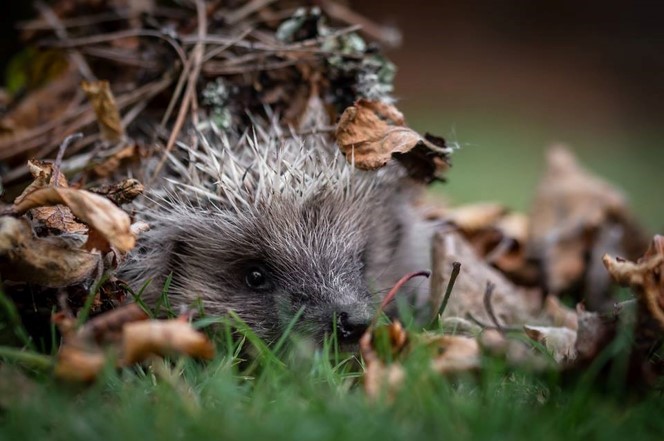
Above: Luna, a resident at the Prickles and Paws Hedgehog Sanctuary
The children of Blisland Primary Academy believe that it is crucial that the world takes action, and prevents these fascinating creatures from becoming extinct. We asked the Year 6 pupils at Pelynt Primary Academy what they thought about the trip to Prickles and Paws Hedgehog Sanctuary and one child said, “I now know ten times more than I used to…especially the technical terms. It’s good to know how we can help, like if we see in the day, it needs to go to the sanctuary.”
Children here at Blisland told us, “We needed to go on that trip, so we could learn more about the hedgehogs from the experts, learn the scientific words and find out why they’re so endangered.”
Because of this experience, the children have been educated well by those experts about conservation and Bridge Stories hopes that they will become the future guardians of nature to actively help hedgehogs.
Emma explained that there are some key things we can all do to help our spiky friends:
- Leave your garden (or outdoor area) messy with leaves, so that the hedgehog can make their cosy new hibernaculums.
- You also want to make sure that the hedgehogs have good access to your garden so there are holes under gates for them or holes in fences (you could have a fenced off area for hedgehogs to stay).
- Finally, if you see a hedgehog out in the day, then it’s probably ill, so make sure you get a pair of thick gloves, and take him to a wildlife sanctuary. Remember: “If it’s out in the day, it’s not OK!”
The schools are now raising money for Prickles and Paws Hedgehog Sanctuary, as a thanks for the free trip they provided and to help them carry on with their good work. They are also going to write poems and send these to the Eden project, who will upload them to their website. This will let the world know that we all need to take action and there’s no time to waste.
Back
Creative: Forest School - A place to grow
By Emily & Ollie, Pelynt Primary School
At Pelynt Primary Academy, every pupil enjoys weekly sessions at ‘Forest School’ to enhance their learning and help them grow physically and intellectually.
Forest School originated in Scandinavia and came to the UK in 1993. It is an official organisation and all of the leaders (like Miss Edwards, the Head of Pelynt) are properly trained to deliver the weekly sessions. It is important that sessions are regular and not just a ‘one-off’, as it is a long -term process. Many people have done research which presents the benefits and the leader shows how to take risks, whilst being safe, because they assess it all first so that the children can just go and enjoy ourselves.
It helps pupils to grow in confidence by going into the wild and having different experiences, such as den building and creating games in pairs or teams. Students are set challenges. They might be given a ‘scavenger hunt’ or ‘making a Victorian toy from natural resources’.
We asked some year six pupils why they thought that it benefited them and one pupil told us, “I’ve learnt a lot more about wildlife and nature and it’s a really fun way of learning”.
It also encourages creativity and helps develop their social skills in what Forest Schools’ call a holistic way. Children feel amazing about themselves afterwards and comfortable around others, which means they can feel much more free and relaxed for the rest of the day. For example, another pupil told us, “Forest School is the most relaxing day of the week for me”.
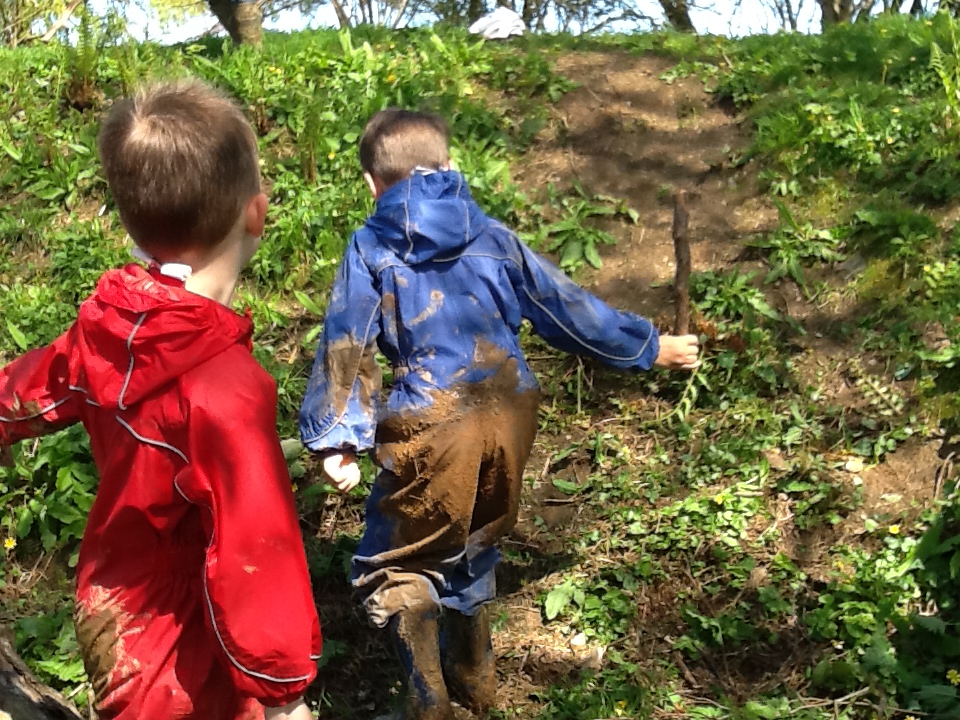
Above: Getting Muddy at Forest Schools
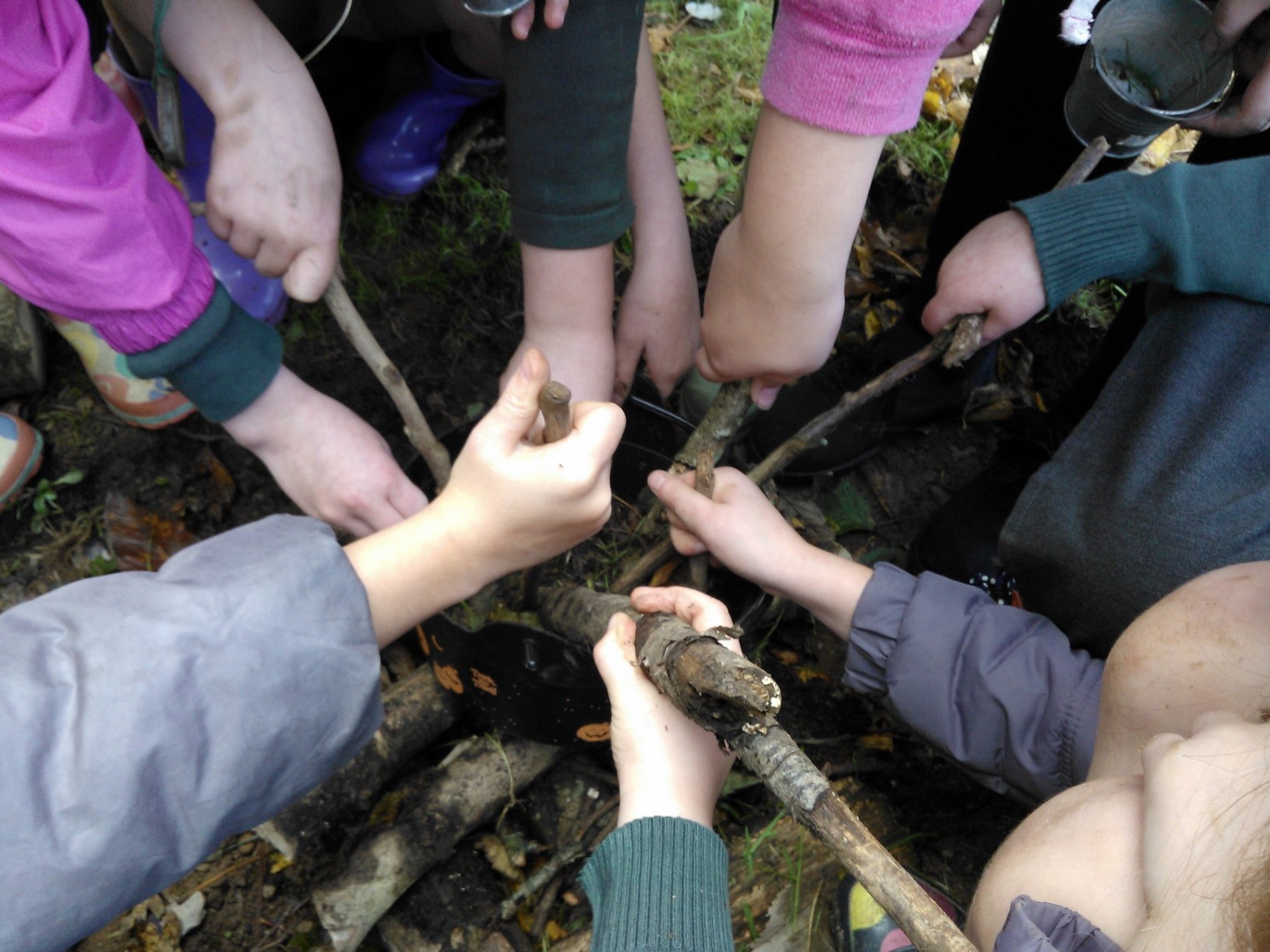
Above: All hands on deck (sticks)
We found out that other schools in Bridge Schools Trust also have Forest School. We asked the Head at Lanlivery Primary Academy why they use it too. Miss Howell (the Head) told us that, “Forest school supports pupils' wellbeing. It challenges what they think they can achieve and pushes them out of their comfort zone. They learn to take risks, solve problems, and try strategies to overcome failure whilst learning about the beautiful, natural world which surrounds them. It is the children's favourite time of the week, which means they enjoy coming to school and look forward to learning”.
We also think that when we look at our school values, Forest schools promotes these because children learn to be curious as they discover new things in nature; creative because they build things like dens and responsible because they learn to be safe taking risks.
Like trees, Forest Schools help us all to grow.
Back
Determined: Running is back 'on track'
By Em and Talula, St Cleer Primary School
At St Cleer Primary Academy, there are a whole range of activities now on offer that promote health and wellbeing. After a challenging two years of lockdowns, the school is ensuring that fitness and sports are an imperative part of school life: keeping fit is good for our bodies, but it also helps our wellbeing.
Unfortunately, the pandemic had an impact; for example two years of cross-country races were cancelled. This has made the school realise that a fresh new emphasis on fitness and wellbeing was needed.
Children at the school have regular PE lessons with expert Oli Jones and take part in ‘Fit Fridays’, but they also have the choice to take part in multiple fitness clubs such as cross-country running, football and cricket. This helps the children keep fit and have a healthy mindset, especially after the lockdowns. These clubs have been a special part of many children’s lives. During the lockdowns, many children followed Joe Wicks’ work outs on the television and this helped them to exercise and feel less cooped up. Research shows that children who exercise have stronger hearts, stronger lungs, higher energy levels and it can also help with emotional wellbeing.
One Year 6 pupil at St Cleer said, “After I do some exercise, I feel refreshed and happy. The school takes part in cross-country clubs and this helps the kids here to train hard and then compete against other schools which is good fun in terms of the element of competition between schools and pupils.”
Two of the Bridge School’s values are determination and enthusiasm. Children need to be determined to train and to win and they also need to be enthusiastic to take part in sports. Sport teaches you good skills for life.

Above: Mrs Spencer completes a 10K run with her friend
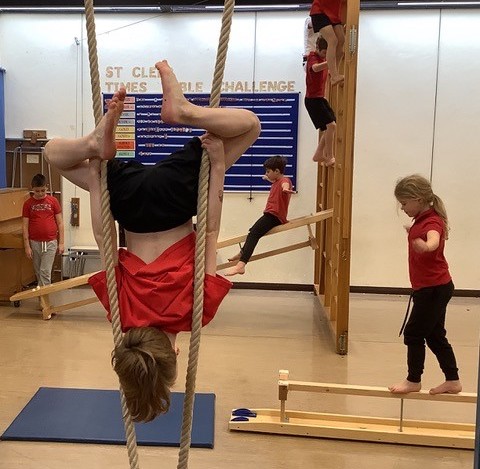
Above: The worlds turned upside down !
Bridge Stories asked Mrs Spencer (the Headteacher) for a comment and she said, “Running for me has always given me a real sense of freedom, particularly when I am running near water. I think it helps with emotions. When I lived in London, it was very flat – I prefer Cornwall as it is harder because it’s hillier, so the challenges are greater and that is more satisfying. Running also helps me to relax after long days at school, so it’s good for me in lots of ways.”
Running isn’t an expensive sport to try…all you need is a pair of trainers and some comfy clothes.
If running isn’t for you, why not try a team sport like basketball, volleyball or rugby. Exercise as often as you can every week and you will start to notice the difference. Go on, give it a go!
Back
Enthusiastic: Truro artefacts amaze all !
By Elowen, St Cleer Primary School
During the spring term, a group of Year 6 pupils at St Cleer Primary Academy were given the chance to become teachers and coach some Year 2 children with their poetry writing.
This small group of talented writers, including an Eden Ambassador, chose to write about the erinaceus europaeus (more commonly known as the hedgehog) as it is on the ‘Red List’ of endangered mammals in Cornwall. The Year 6 pupils and the Year 2 pupils have been writing acrostic poems and using their research to find new and improved vocabulary for their writing.
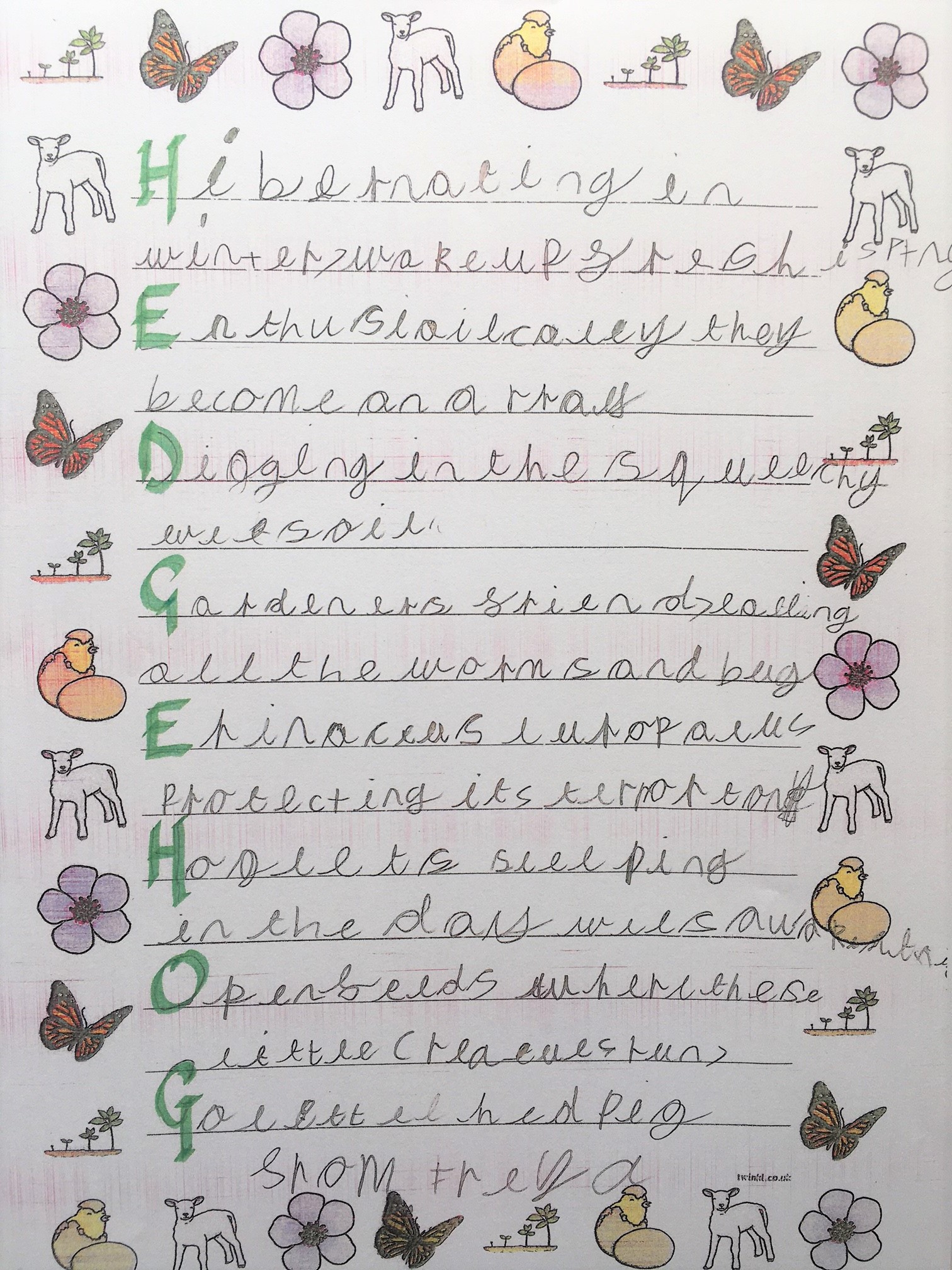
Above: Hedgehog Poem
This is a new angle for the Eden Ambassador, who has been part of Eden’s ‘Found Words’ project. This is a joint project between Eden and Bridge Schools where children wrote poems based on the book, “The Lost Words” and then created videos and slides to teach other children how to care for nature and write with an environmental message and passion.
The Eden Ambassador told us, “Teaching the Year 2s was a bit daunting because we weren’t used to teaching and so we had to simplify things for them, like the vocabulary we used and the way we said things, or how much time they might need for their writing. It helped me realise how hard it can be for teachers. Our Year 2s were very imaginative and really good at poetry!”
At St Cleer Primary Academy there is a strong belief that this work reflects many of the school values as the children were all very curious to learn more about the hedgehogs. The Year 6s were also responsible for the Year 2s and the sessions were very creative.
Year 2 teacher Miss Wright said, “It's been a pleasure to see the Year 2s working with the Year 6s. The writing they've produced has been fantastic. Well done everyone!
If you would like to get involved with the Found Words Project click here.
You can enter a poem, a drawing or a painting about an animal or plant you would like to see protected and tell important messages about looking after the earth’s wildlife to children all around the world.
Back
Excellent: Back in the Days of St Cleer
By Phiel and Brendan, St Cleer Primary School
At St Cleer Primary Academy, the children and staff feel so lucky to be a part of this community and have been actively researching facts about the school because we are curious (which is one of our school values!) We would like to share some of these with you.
St Cleer is situated near the town of Liskeard - a small village which consists of just around 4,000 people. It also sits just on the outskirts of the hamlet of Tremar and not too far from Pensilva. There is plenty of beautiful wildlife surrounding the village. This small village welcomes people with opens arms and is a popular spot for a quiet cottage life.
St Cleer School became a part of this community in 1877. The first headteacher in St Cleer was George Noble (June 25,1877 - April 16,1880). He only stayed for three years, whereas today, our very own Mrs Rowe has been with us since 1999 (23 years).
Landmarks in St Cleer:
Many interesting landmarks are situated in this fascinating village such as a church, which is believed to be hundreds of years old and a holy well which is a very popular sight to see for many people from all walks of life. The well, which was built in the 1400s, (15th century) measures 3.38m east-west by 3.08m north-south. The building is constructed of large granite stones and is surrounded by many historical, decorative crosses. The well is also surrounded by a lovely selection of wildlife and many people often stop on a walk to look at this historical treasure. The church (St Clarus) stands in the middle of the village, which is just on the edge of Bodmin Moor and has been an enjoyable visit for many families over the years at the Sunday church services. Here at St Cleer we keenly take part in celebrations at this church, such as harvest festival and school nativities, where we all sing together. This wonderful destination was built in AD 800 and is full of historical facts!
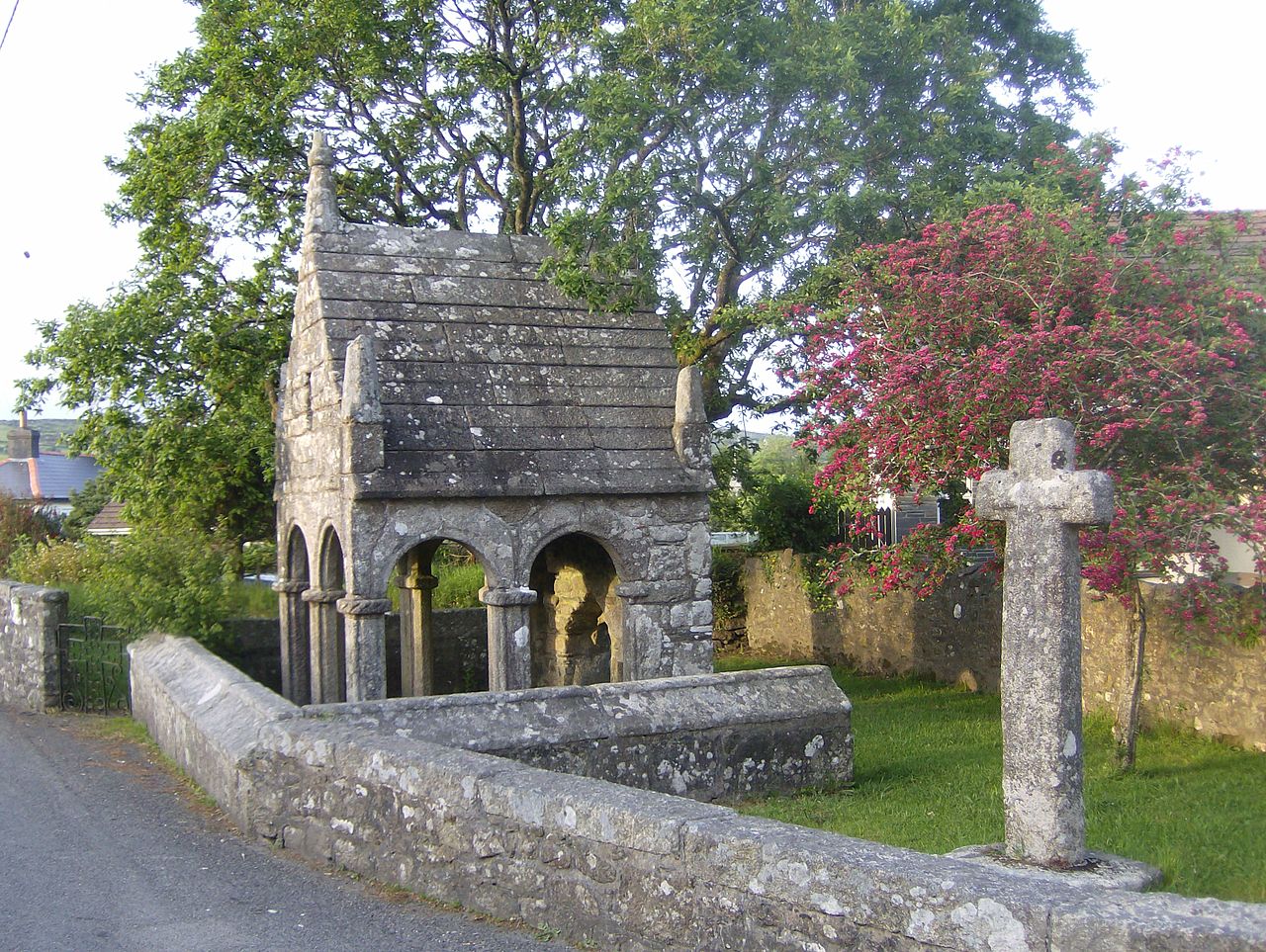
Above: St Cleer Well
War in St Cleer:
You might not realise this, but in September 4th 1939, an evacuation was ordered and several children from St Cleer were evacuated overseas to Canada, Australia and the United States. The evacuees were all given a gas mask and they had food for the journey to the country side. Being an evacuee must have been scary and exciting. Children had labels attached to them, as though they were parcels.
Mining:
Just near to St Cleer there is a mine called south Caradon mine, which was started in 1833; it closed in 1836 and in that time, it produced over 200,000 tons of copper ore. The mine site occupies the southern flank of Caradon hill and the valley of the river. Lots of mines are in St Cleer such as the Larkholes, Penhale and the Trecarne mine. In the mines they mined for tin, copper, silver and lead. Inside Caradon mine you can find debris and remains, it also was meant to be a copper mine. The dangers of working in a mine were cave-ins, explosions, toxic air and extreme temperatures! It was such a dangerous job, for example in 2019 Cornwall marked 100 years since the Levant mining disaster killed 31 men. All of these mines are now closed, however we still get to enjoy their remains to learn about their important history and the contributions they have made to Cornwall.
We are proud of our local history and we have even been learning a song about the history of St Cleer, written by our wonderful music teacher Mr Warwick. We are hoping that you will be able to listen to it – you can find the link here and see us singing together in the playground.
It’s also all about being kind, which is part of being responsible (another one of our school values!)
Back
Bridge Stories
Archive
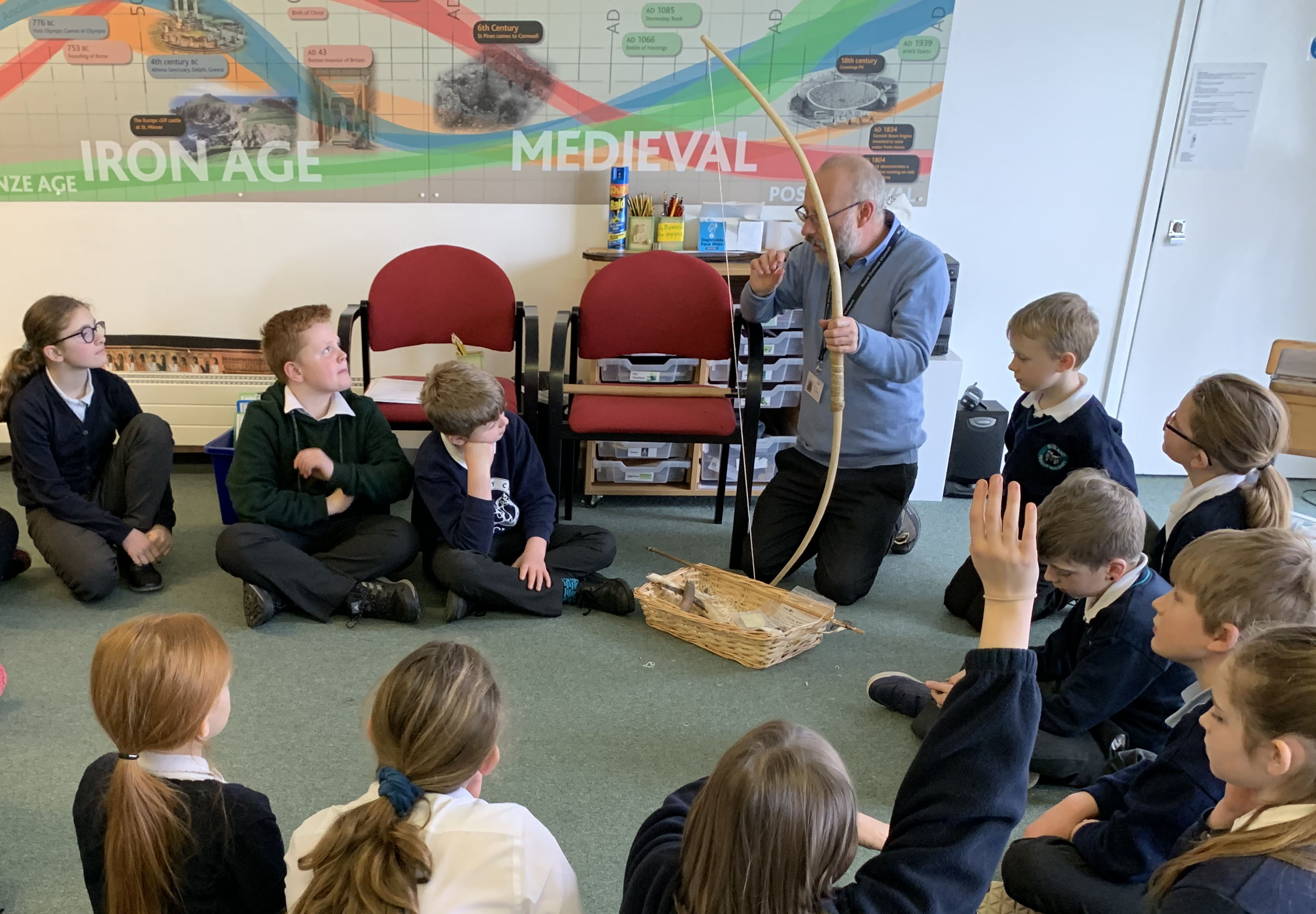 <
<
Coming in Issue 3
More lessons in learning through our Trust values.
© 2025 Bridge Schools trust is a company limited by guarantee, registered in England and Wales. Registration number 7736425. It is an exempt charity.

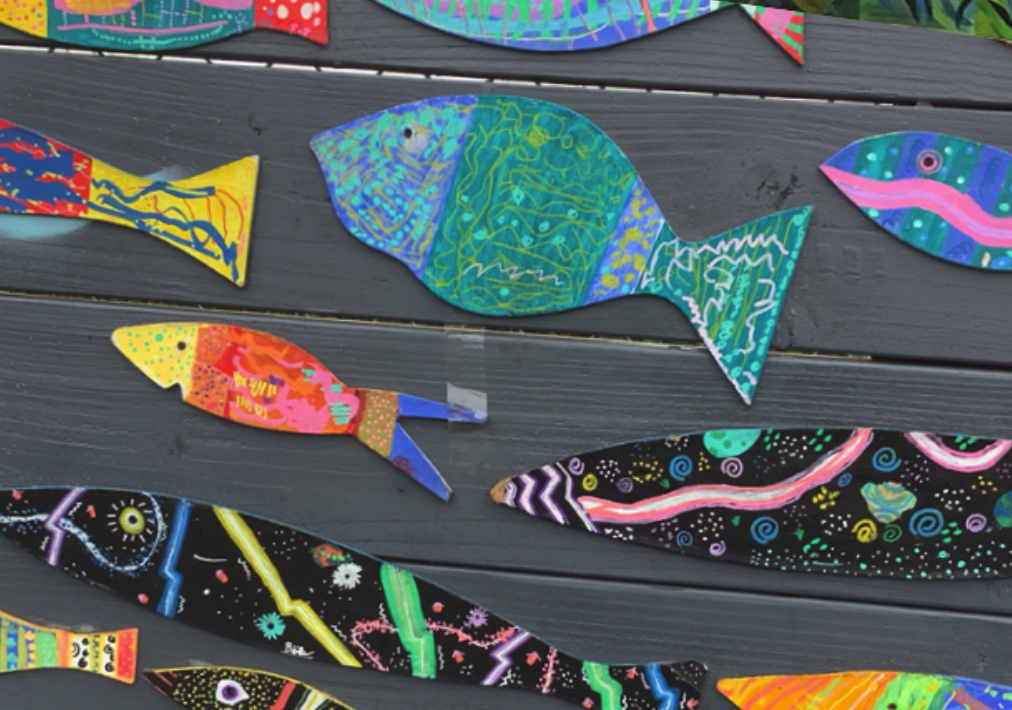 <
<